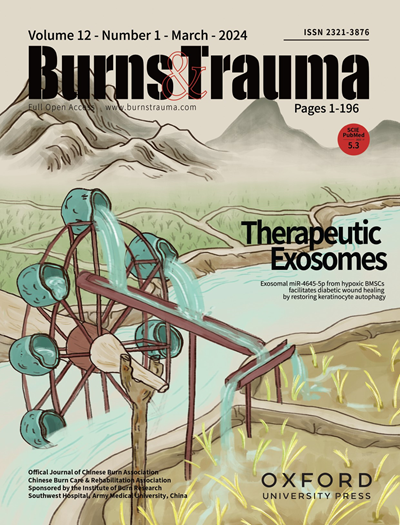感染性休克的血流动力学处理
IF 9.6
1区 医学
Q1 DERMATOLOGY
引用次数: 0
摘要
感染性休克是烧伤和创伤性损伤患者并发感染时的重大挑战,需要及时有效的血流动力学支持。这篇综述全面概述了感染性休克中血管加压剂和液体管理的当前策略,旨在优化患者的预后。关于血管加压素的管理,我们详细阐述了儿茶酚胺、血管加压素衍生物、血管紧张素II和其他血管活性药物的药理学特征和临床应用。去甲肾上腺素仍然是感染性休克治疗的核心。在去甲肾上腺素的基础上依次添加抗利尿激素,可产生非儿茶酚胺类血管活性作用,具有一定的临床益处和不良反应风险。新兴药物如血管紧张素II和羟钴胺素因其在儿茶酚胺抵抗性血管舒张性休克中的作用而受到重视。其次,对于液体管理,晶体液目前首选用于初始复苏,平衡晶体液比生理盐水更有利。白蛋白在感染性休克中的应用有待进一步研究。高质量证据不支持大容量液体复苏,建议采用基于血流动力学参数的个体化策略,包括乳酸清除率和毛细血管再充血时间。现有的知识表明,在液体复苏效果不足的情况下,早期血管加压剂,特别是去甲肾上腺素的启动可能是至关重要的。难治性感染性休克的治疗仍然具有挑战性,血管紧张素II和亚甲基蓝等新型药物在最近的研究中显示出潜力。总之,需要进一步的研究来优化脓毒性休克的血流动力学管理,特别是在开发新的血管加压剂使用和液体管理方法方面。本文章由计算机程序翻译,如有差异,请以英文原文为准。
Haemodynamic management of septic shock
Septic shock is a significant challenge in the management of patients with burns and traumatic injuries when complicated by infection, necessitating prompt and effective haemodynamic support. This review provides a comprehensive overview of current strategies for vasopressor and fluid management in septic shock, with the aim to optimize patient outcomes. With regard to vasopressor management, we elaborate on the pharmacologic profiles and clinical applications of catecholamines, vasopressin derivatives, angiotensin II, and other vasoactive agents. Noradrenaline remains central to septic shock management. The addition of vasopressin, when sequentially added to noradrenaline, offers a non-catecholaminergic vasoactive effect with some clinical benefits and risks of adverse effects. Emerging agents such as angiotensin II and hydroxocobalamin are highlighted for their roles in catecholamine-resistant vasodilatory shock. Next, for fluid management, crystalloids are currently preferred for initial resuscitation, with balanced crystalloids showing benefits over saline. The application of albumin in septic shock warrants further research. High-quality evidence does not support large-volume fluid resuscitation, and an individualized strategy based on haemodynamic parameters, including lactate clearance and capillary refill time, is recommended. The existing knowledge suggests that early vasopressor initiation, particularly noradrenaline, may be critical in cases where fluid resuscitation takes inadequate effect. Management of refractory septic shock remains challenging, with novel agents like angiotensin II and methylene blue showing potential in recent studies. In conclusion, Further research is needed to optimize haemodynamic management of septic shock, particularly in developing novel vasopressor usage and fluid management approaches.
求助全文
通过发布文献求助,成功后即可免费获取论文全文。
去求助
来源期刊

Burns & Trauma
医学-皮肤病学
CiteScore
8.40
自引率
9.40%
发文量
186
审稿时长
6 weeks
期刊介绍:
The first open access journal in the field of burns and trauma injury in the Asia-Pacific region, Burns & Trauma publishes the latest developments in basic, clinical and translational research in the field. With a special focus on prevention, clinical treatment and basic research, the journal welcomes submissions in various aspects of biomaterials, tissue engineering, stem cells, critical care, immunobiology, skin transplantation, and the prevention and regeneration of burns and trauma injuries. With an expert Editorial Board and a team of dedicated scientific editors, the journal enjoys a large readership and is supported by Southwest Hospital, which covers authors'' article processing charges.
 求助内容:
求助内容: 应助结果提醒方式:
应助结果提醒方式:


